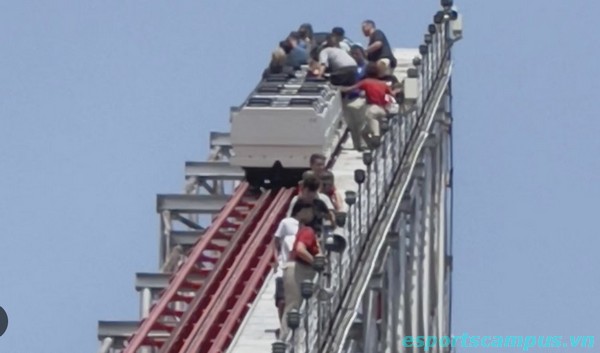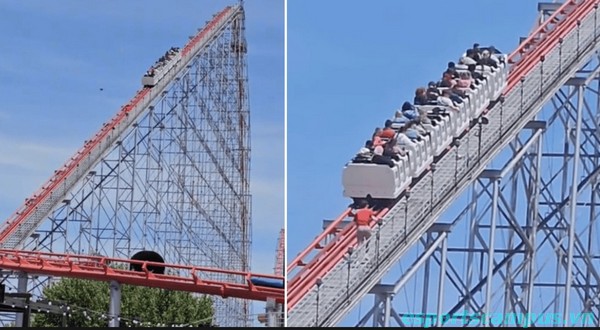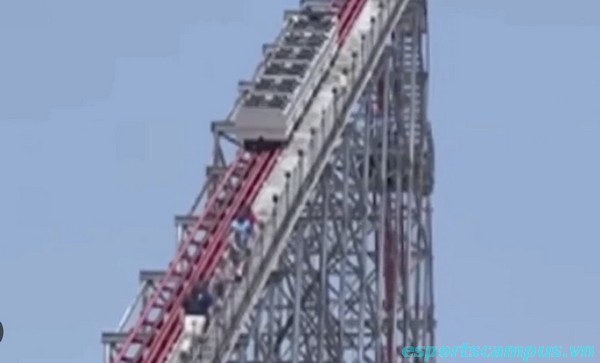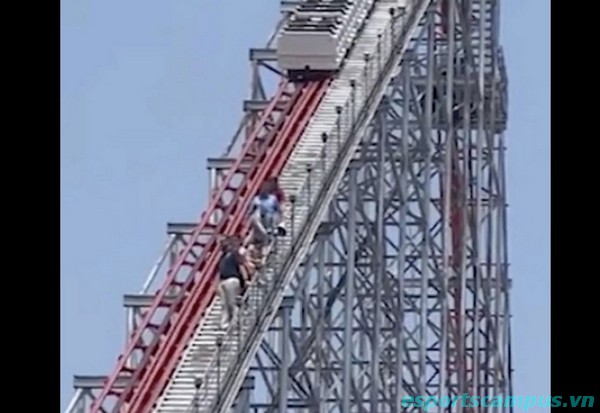Cedar Point Roller Coaster Stuck: Passengers stuck on high
In what should have been a day filled with exhilarating thrills and unforgettable memories, the Cedar Point roller coaster stuck amusement park in Sandusky, Ohio, experienced an unexpected turn of events that left its visitors on edge. The Magnum XL-200, a renowned roller coaster known for its heart-pounding drops and breathtaking heights, encountered a mechanical failure that brought the ride to a sudden halt. Passengers found themselves stranded high above the ground, uncertain of what had caused the roller coaster to be stuck. The incident ignited public concern and raised questions about the park’s safety protocols. This unexpected interruption has since sparked a comprehensive review of safety and maintenance practices across the amusement park industry. Follow esportscampus.vn!

I. Introduction to the cedar point roller coaster stuck
At Cedar Point amusement park in Sandusky, Ohio, a serious incident occurred on a fateful Monday, sending shockwaves through the park and its visitors. The adrenaline-pumping Magnum XL-200 roller coaster, known for its heart-stopping thrills and exhilarating drops, was marred by a sudden and unexpected mechanical failure, leaving passengers stranded in mid-air. The once-exciting ride turned into a nerve-wracking experience as the coaster came to an abrupt halt at the peak of its 205-foot hill, trapping riders helplessly on board.
The atmosphere at Cedar Point roller coaster stuck quickly shifted from one of laughter and excitement to concern and uncertainty. As word spread about the roller coaster’s malfunction, park employees rushed to the scene to assess the situation and ensure the safety of the stranded passengers. Fearful eyes gazed up at the towering structure, where a normally thrilling adventure had turned into an unsettling ordeal for those trapped on the Magnum XL-200.
This incident has reignited the long-standing debate over roller coaster safety and maintenance in amusement parks. Cedar Point, known for its record-breaking rides and high-octane experiences, has always prided itself on delivering unforgettable moments to its visitors. However, the recent unexpected failure of Magnum XL-200 has left both the park management and the public questioning the effectiveness of safety protocols and maintenance practices.
II. Details of the Incident
1. Magnum XL-200: Towering 205 Feet
The Magnum XL-200, an iconic roller stuck coaster at Cedar Point, holds a special place in the hearts of thrill-seekers around the world. Since its grand debut in 1989, it has been a symbol of extreme excitement, boasting a staggering height of 205 feet. As riders board the coaster, a mixture of exhilaration and trepidation washes over them, knowing that they are about to experience an adrenaline rush like no other.
Ascending the lift hill, passengers are treated to breathtaking views of the surrounding park and Lake Erie. The anticipation builds as the coaster steadily climbs higher, reaching the peak of its towering structure. At this point, a momentary pause allows riders to catch their breath before plunging into a series of stomach-churning drops and high-speed twists.
With a top speed of 72 miles per hour, the Magnum XL-200 hurtles down the tracks, delivering an electrifying rush to all who dare to embark on its wild journey. The coaster’s design, which incorporates airtime hills and a breathtaking finale, has earned it a reputation as one of the fastest and steepest roller coasters in the world.
However, on this unfortunate Monday, the thrill turned into apprehension when the Magnum XL-200 experienced an unexpected and alarming mechanical failure. At the coaster’s highest point, the ride came to a sudden stop, leaving passengers suspended in mid-air, some dangling at a steep angle. The once exuberant screams of delight turned into uneasy murmurs as riders waited, unsure of what was happening or how long they would be stuck.
2. Mechanical Failure: An Unexpected Halt
As the Magnum XL-200 soared to its peak, the roller coaster’s mechanical components suddenly encountered an unforeseen issue, triggering a crucial safety mechanism to halt the ride. The “engine check” warning light flashed, indicating a problem that required immediate attention. In response to the warning, the coaster’s automated system activated a fail-safe procedure, bringing the train to an abrupt stop, leaving the riders suspended high above the ground.
Passengers on board, expecting a thrilling descent, found themselves in a surreal and unsettling situation. The uncertainty of the mechanical failure only added to their anxiety, and they eagerly awaited communication from the park’s staff. With each passing moment, the realization set in that this was not part of the ride’s intended excitement.
While Cedar Point’s employees, well-trained in emergency protocols, acted swiftly to assess the situation and communicate with the stranded riders, the minutes felt like an eternity for those trapped on the coaster. Safety harnesses securely held the passengers in place, but the suspense and discomfort of being suspended in mid-air became palpable.
As park engineers and maintenance teams rushed to the scene, their priority was to ensure the safety of the passengers and identify the root cause of the mechanical failure. With the Magnum XL-200 being one of Cedar Point’s star attractions, the park’s management understood the gravity of the situation and the need for a meticulous investigation.

III. Previous Incident – Wild Mouse Roller Coaster
Prior to the recent incident with the Magnum XL-200, Cedar Point faced another roller coaster malfunction that left passengers unnerved and concerned about their safety. The Wild Mouse roller coaster, a popular attraction known for its hairpin turns and sudden drops, encountered an unexpected stoppage during one of its routine rides.
On that fateful day in May, passengers aboard the Wild Mouse roller coaster were taken by surprise as the ride came to an abrupt halt while navigating one of its thrilling turns. The coaster’s safety system detected a potential issue, prompting an immediate stop to prevent any further complications. As the coaster jolted to a halt, riders found themselves in a precarious position, stranded on the track with no immediate way to continue the journey.
As with the recent incident, Cedar Point’s well-trained employees swiftly responded to the situation, implementing the necessary emergency protocols to ensure the safety of the stranded passengers. With the coaster stopped on a hill, passengers remained suspended, awaiting further instructions and assistance from the park staff.
For approximately 30 minutes, the passengers anxiously waited for rescue as park employees worked diligently to safely evacuate them from the stranded coaster. One by one, riders were guided down the coaster’s structure using carefully planned evacuation procedures. While the situation was certainly unsettling, the professionalism of the park’s staff during the evacuation process provided some reassurance to the passengers.

IV. Cedar Point response
In the wake of the incidents involving the Magnum XL-200 and the Wild Mouse roller coasters, Cedar Point found itself facing a wave of public concern and media scrutiny. Visitors and the wider community sought answers from the amusement park regarding the safety and reliability of its attractions. However, in the immediate aftermath of the incidents, Cedar Point’s communication team opted for a cautious approach, refraining from making public statements until a thorough investigation had been conducted.
The park’s management acknowledged the significance of the incidents and understood the importance of addressing the public’s concerns promptly and transparently. While awaiting the findings of the investigations, Cedar Point initiated internal reviews of its maintenance and safety protocols to identify any potential shortcomings or areas for improvement. The safety and well-being of visitors remained the top priority throughout this process.
Over the next few days, as the investigations progressed, Cedar Point officials met with representatives from safety regulatory bodies to discuss the incidents and share their commitment to implementing any necessary changes. The park demonstrated a willingness to collaborate with industry experts and adhere to the highest standards of safety within the amusement park community.
As the park worked diligently to restore confidence, Cedar Point’s spokesperson made a public statement expressing empathy for the passengers who had experienced anxiety during the incidents. The spokesperson emphasized that Cedar Point was taking the situation seriously and pledged to share the results of the investigations with the public once they were concluded.

V. The Need for Safety and maintenance review
The incidents involving the Magnum XL-200 and Wild Mouse roller coasters at Cedar Point have shed light on the critical importance of regular safety evaluations and maintenance practices within the amusement park industry. As these incidents captured public attention and prompted discussions about roller coaster safety, the need for comprehensive reviews has become evident not only for Cedar Point but also for amusement parks across the nation.
1. Reassessing Safety Protocols
The incidents at Cedar Point serve as a stark reminder that thrill-seekers place their trust in the hands of amusement parks, expecting not only excitement but also the assurance of their well-being. Theme parks, therefore, have a profound responsibility to uphold the highest safety standards to safeguard their visitors.
The safety protocols governing roller coasters and other attractions must be continually scrutinized and adapted to address potential risks and emerging concerns. Cedar Point’s response to the incidents, including the establishment of an external safety advisory committee, sets a positive example for other parks to follow. Collaborating with industry experts and safety regulators can provide valuable insights and recommendations to enhance safety measures.
Moreover, park employees must undergo rigorous training and periodic evaluations to ensure they are well-prepared to handle emergencies effectively. This training should cover all aspects of ride operations, from routine maintenance checks to efficient evacuation procedures in the event of a malfunction.
2. Prioritizing Preventative Maintenance
Preventative maintenance is paramount to the continued safe operation of roller coasters and other amusement park rides. Regular inspections, routine checks, and the prompt addressing of any detected issues are crucial to avoiding unexpected failures. Parks must invest in advanced monitoring systems and cutting-edge technologies that can detect potential malfunctions before they escalate into safety hazards.
Cedar Point’s decision to temporarily close the Magnum XL-200 and Wild Mouse roller coasters for inspections demonstrates the commitment to ensuring guest safety. This practice is a model for the industry to follow, illustrating that prioritizing maintenance over operational profits is an investment in both visitor satisfaction and long-term reputation.
3. Sharing Best Practices
Safety should not be a competitive matter within the amusement park industry. Instead, parks should foster a collaborative environment, sharing best practices, and learning from one another’s experiences. Safety conferences, workshops, and forums can be instrumental in disseminating knowledge and facilitating meaningful discussions among park operators, engineers, and safety experts.
By learning from incidents and adopting industry-wide best practices, amusement parks can collectively enhance safety standards and mitigate potential risks. The ultimate goal is to create a culture of continuous improvement, where the well-being of visitors remains at the core of every decision made.
4. Transparency and Communication
Amusement parks play a vital role in society’s enjoyment and leisure, and with that role comes a responsibility to be transparent and communicative with visitors. In the face of incidents, timely and accurate information sharing is essential to build trust and reassure the public.
Cedar Point’s commitment to providing regular updates during the investigations exemplifies the importance of transparency. Visitors appreciate knowing that the park takes incidents seriously and is diligently working to address any concerns raised.
VI. Conclusion cedar point roller coaster stuck
The roller coaster incidents at Cedar Point have prompted a critical reevaluation of safety and maintenance practices within the amusement park industry. As one of the nation’s premier amusement parks, Cedar Point’s response to the incidents has set a precedent for transparency, accountability, and a commitment to visitor safety.
The incidents involving the Magnum XL-200 and Wild Mouse roller coasters served as wake-up calls for both Cedar Point and the wider amusement park community. Cedar Point’s willingness to collaborate with industry experts and regulatory bodies to conduct thorough investigations reflects the park’s dedication to providing a safe and enjoyable experience for its guests.
The need for constant reassessment of safety protocols cannot be overstated. Amusement parks must adopt a proactive approach, implementing rigorous employee training programs and leveraging advanced monitoring technologies to detect potential issues before they escalate. Cedar Point’s decision to prioritize preventative maintenance over operational profits by temporarily closing roller coasters for inspections is a testament to their commitment to guest safety.